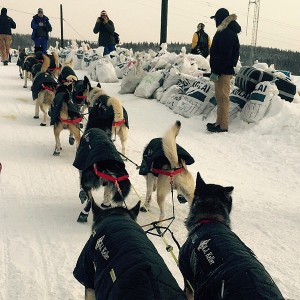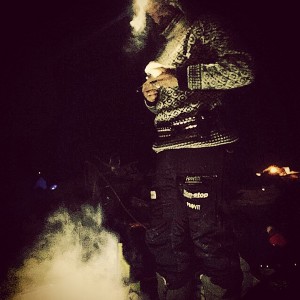Mushers are allowed to start the Iditarod with a maximum of 16 dogs. More than a third of way into the race, many teams are still that large because of a combination of easy-going river miles, good dog care and support from fellow mushers.
As the sun set over the Galena dog yard, musher Travis Beals walked up and down his line of dogs, sprinkling ground salmon in front of each one.
Beals’ original race plan did not include a 24-hour layover in Galena, but when arrived at the checkpoint, he realized his 14 dogs needed the rest.
“I had a couple sore dogs – key members of the team that needed some attention,” Beals said.
Because he hadn’t planned to stop for long, Beals didn’t have enough food to last 24 hours.

“Mushers are the type of people – they’re always willing to lend a hand and DeeDee’s leaving now and she’s got a smorgasbord of stuff,” he said.
DeeDee Jonrowe was parked a few feet away. She only planned to stop in Galena for a few hours, so before she pulled out of the checkpoint, she handed Beals all of her leftover dog food.
Jonrowe: “I understand because that’s happened with me before.
Beals: “It’s not that I didn’t pack. It’s either behind me in Ruby or [ahead] in Huslia or Koyukuk, you know.”
Jonrowe: “What’s happened with me too is planning to not have as big a team. Because on the coast with 14 dogs, well they ate everything I had and so, I totally have been there.”
Jonrowe is running the Iditarod for a 33rd time. As she packed her sled to go, she said she was glad hers is among a number of teams that have remained large this year.
“If you look at the data, in cold years they often do for a while,” she said. “It just depends on a person’s ability to hold it together with dog care.”

Paige Drobny still has 15 dogs in her team. She says this year’s reroute may have something to do with fewer dropped dogs.
“The teams are all really big and I think that shows how forgiving more of the trail is because we’ve been on flat river running instead of going through the gorge that can maybe knock dogs out of the competition faster,” Drobny said.
But some of those flat river miles have been hard-packed, so dogs are showing up with sore wrists. Those are injuries musher Richie Diehl did not expect.
“We’re going to work on it and try to get it all straightened out and move on down the trail,” he said. “It’s just frustrating, you know? Dogs that I’ve had to drop who have been some of my most durable all year, you know, and I had to leave them behind. But I mean that’s part of dog racing.”
Diehl wants to massage sore muscles and wrists during his 24-hour layover. He’ll leave Galena with one of the smaller teams in the field.
“I thought I would have more right now, I definitely do,” Diehl said. “But 12 is a big team too. You can do a lot with 12 dogs, so I’m not worried.”
For Aliy Zirkle, it’s continued cold weather that’s causing worry.
“It’s difficult to put extra attention to dog care when it’s cold, because your ointment’s frozen, Algyval is frozen, your hands are frozen, your protective gear is frozen,” she said.
The next two runs exceed 80 miles each – long, by Iditarod standards, and teams will leave the flat, forgiving river for a rougher, forested route.




